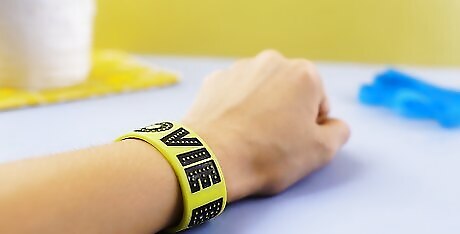
views
Boiling the Bracelet

Fill a pot with 2 inches (5.1 cm) of water and bring it to a boil. Fill the pot with enough water to cover the bracelet once you put it in. Set the stove to high and wait until the water is at a rolling boil. It doesn't matter what kind of saucepan you use, as long as there's enough water in it.

Place the bracelet into the boiling water for 10 to 15 seconds. Use tongs to put the bracelet in the water and count to 10 or 15. If the bracelet is way too big on your wrist, it won’t hurt to leave it in for 20 seconds. The longer you leave the bracelet in the water, the more it will shrink. Say “Mississippi” between each number so you’re counting as close to real seconds as possible. Don’t drop the bracelet into the pot because boiling water could splash up and burn your hand.

Remove the bracelet with tongs and let it dry completely. Lift the bracelet out of the water and place it on a paper towel or rag to dry. Squeeze it with a thick towel to get rid of excess moisture so it can dry and cool off faster. Pour the water down the sink and wash the saucepan really well before you use it for anything else.

Try the bracelet on to see if it's a good fit. Once the bracelet's cool to the touch, put it on to see if you like how it fits. If it's still too loose, boil it for another 5 minutes, let it dry, and try it again. Keep boiling and drying it until it’s the right size.

Stretch out the bracelet if you overboiled the bracelet and it’s too small. If the bracelet ends up shrinking too much, stretch it with your hands or loop it on something sturdier (like a doorknob) and stretch it. Silicone is pretty strong, so don’t worry about breaking it. The boiling water doesn’t make the band weaker because silicone is heat-resistant, and it can keep its structure in temperatures as high as 446°F (230°C)!
Cutting and Gluing the Bracelet Back Together

Measure your wrist with a tape measure to find your perfect fit. Wrap a flexible tape measure around your wrist and write down the value in inches or centimeters. Add about 1 inch (2.5 cm) to that number to find how long your bracelet should be. For example, if your wrist is 6.5 inches (17 cm) around, the ideal bracelet size is 7.5 inches (19 cm). If you want a snug fit, only add ⁄2 inch (1.3 cm) to the size of your wrist. Just remember that you'll need to be able to pull it over your hand to put it on. Adding an extra inch to your wrist size ensures the bracelet will be loose enough to put on and take off.

Use scissors to cut the band where there's no design or logo. Pick a discreet place to cut the band so you won't notice a break in the design once you put it back together. Snip the band in half with a sharp pair of scissors. Make the cut as even as you can so there are no jagged edges or curves in the cut. That’ll make it easier to bond it back together. Avoid using a pocket knife or dull scissors you use for everyday purposes. Sharp scissors made for cutting hair, fabric, or craft materials are a good choice.

Lay the bracelet and tape measure side by side and mark your perfect length. Lay both pieces side by side on top of a piece of paper. Make a small mark on the paper where the inch-value of your wrist is. Add 1 inch (2.5 cm) to that and make a second mark on the paper—that’s where you’ll need to cut the bracelet. If you’re worried about the bracelet being too tight, only add ⁄2 inch (1.3 cm) or ⁄4 inch (1.9 cm) to the measurement.

Hold the bracelet with your fingernail at the proper length and snip off the excess. Now that you know how long the bracelet should be, grab the bracelet and position your finger on that point so you know where to cut. Put the blade of the scissors right next to your fingernail marking the point and snip off the excess material. Make it a single, clean-cut so you won't have to deal with gluing a curved or jagged edge.

Apply rubber cement to one edge of the band. Squeeze the tube to apply a thin strip of rubber cement to the cut edge of the bracelet. Use a glue that has a very fine applicator tip so you won't end up with globs of dried glue on your bracelet. If you only have rubber cement with a brush applicator, use a very fine paintbrush to apply the cement instead. Don't use epoxies, school glue, or glues intended for paper because they won't work well (or at all) on silicone rubber. Clear Super Glue, PASCOFix, Sil-Poxy or Elmer's Rubber Cement are all good choices for silicone bracelets.

Hold the 2 cut edges of the bracelet together for 2 minutes. Carefully align the snipped edges and push them together for a good 2 minutes. The idea is to set the glue without letting any pockets of air get between the 2 edges of the bracelet. That way, it stays together longer. It's okay if you see glue squeeze out from between the pieces—it’ll dry clear.

Let the rubber cement dry for at least 1 day. Place the bracelet in a warm, well-lit area and wait for it to dry completely before you try to put it on. A windowsill is a good spot to put it because the more heat and light it gets, the faster it will dry and the sooner you'll get to wear your custom-fitted bracelet. The glue may feel dry but leave it alone—it won't reach its full strength for at least 24 hours after the application. To speed up the drying time, hit it with some hot air from a hairdryer for 1 or 2 minutes.

Slide it over your hand gently to put it on and take it off. The cut and glued bracelet will be more prone to break if you overstretch it, so slide it onto your hand extra carefully. When you take it off, cup your hand so you won’t have to stretch the band too much to get it over your palm and fingers. The bracelet is waterproof, but you should take it off before swimming or bathing because too much moisture can weaken some types of rubber glue over time.




















Comments
0 comment